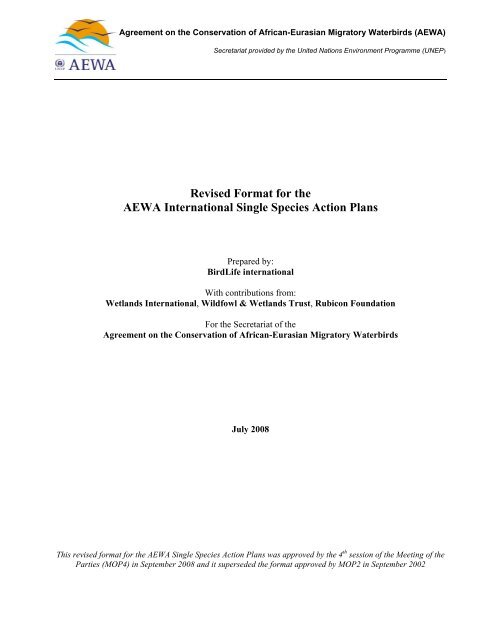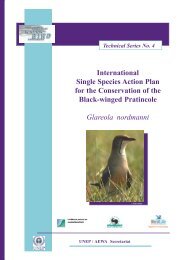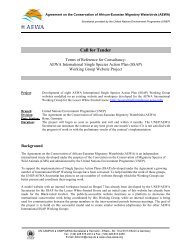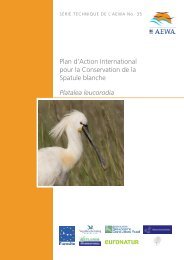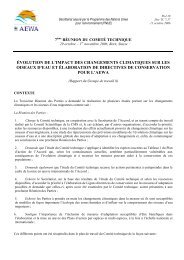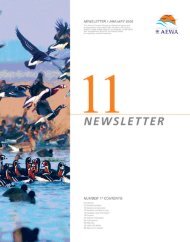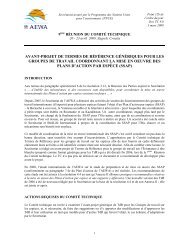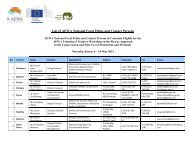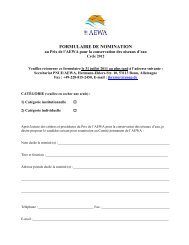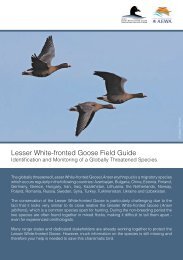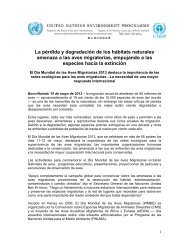Revised Format for the AEWA International Single Species Action ...
Revised Format for the AEWA International Single Species Action ...
Revised Format for the AEWA International Single Species Action ...
You also want an ePaper? Increase the reach of your titles
YUMPU automatically turns print PDFs into web optimized ePapers that Google loves.
Agreement on <strong>the</strong> Conservation of African-Eurasian Migratory Waterbirds (<strong>AEWA</strong>)<br />
Secretariat provided by <strong>the</strong> United Nations Environment Programme (UNEP)<br />
<strong>Revised</strong> <strong>Format</strong> <strong>for</strong> <strong>the</strong><br />
<strong>AEWA</strong> <strong>International</strong> <strong>Single</strong> <strong>Species</strong> <strong>Action</strong> Plans<br />
Prepared by:<br />
BirdLife international<br />
With contributions from:<br />
Wetlands <strong>International</strong>, Wildfowl & Wetlands Trust, Rubicon Foundation<br />
For <strong>the</strong> Secretariat of <strong>the</strong><br />
Agreement on <strong>the</strong> Conservation of African-Eurasian Migratory Waterbirds<br />
July 2008<br />
This revised <strong>for</strong>mat <strong>for</strong> <strong>the</strong> <strong>AEWA</strong> <strong>Single</strong> <strong>Species</strong> <strong>Action</strong> Plans was approved by <strong>the</strong> 4 th session of <strong>the</strong> Meeting of <strong>the</strong><br />
Parties (MOP4) in September 2008 and it superseded <strong>the</strong> <strong>for</strong>mat approved by MOP2 in September 2002
Introduction to <strong>the</strong> revised <strong>Single</strong> <strong>Species</strong> <strong>Action</strong> Plan <strong>for</strong>mat<br />
<strong>International</strong> <strong>Single</strong> <strong>Species</strong> <strong>Action</strong> Plans are <strong>the</strong> key instrument developed under <strong>AEWA</strong> <strong>for</strong> <strong>the</strong> purpose of<br />
implementing coordinated measures to restore and/or maintain migratory waterbird species in favourable<br />
conservation status.<br />
In 2002, <strong>the</strong> <strong>AEWA</strong> Secretariat requested BirdLife <strong>International</strong> to develop a <strong>for</strong>mat <strong>for</strong> <strong>International</strong> <strong>Single</strong><br />
<strong>Species</strong> <strong>Action</strong> Plans drawn up under <strong>the</strong> Agreement. The SSAP developed <strong>the</strong>n has been in use <strong>for</strong> five years.<br />
Fifteen species have been subject to action planning using <strong>the</strong> SSAP <strong>for</strong>mat. In addition, <strong>the</strong> <strong>for</strong>mat has been widely<br />
adopted and used by international organisations (such as <strong>the</strong> EU). Thus, considerable practical experience in SSAP<br />
development, implementation, monitoring, evaluation and revision has been accumulated, which allows a critical<br />
review of <strong>the</strong> process and <strong>the</strong> document template to be made.<br />
In 2008 <strong>the</strong> <strong>AEWA</strong> Secretariat asked BirdLife <strong>International</strong> to evaluate <strong>the</strong> per<strong>for</strong>mance and revise <strong>the</strong> SSAP<br />
<strong>for</strong>mat, based on <strong>the</strong>ir experience. A key group of representatives of BirdLife <strong>International</strong>, Wetlands <strong>International</strong>,<br />
Wildfowl & Wetlands Trust and <strong>the</strong> Rubicon Foundation ga<strong>the</strong>red in February 2008 in Brussels to undertake this<br />
review.<br />
Following this meeting a revised version of <strong>the</strong> SSAP <strong>for</strong>mat, with detailed Guidelines to support its users was<br />
developed.<br />
The revised SSAP <strong>for</strong>mat is simpler, clearer and will lead to more focused action plans, listing a coherent set of<br />
actions based on sound logic.<br />
The descriptive sections of <strong>the</strong> SSAP have been shortened and simplified, in order to concentrate on essential<br />
baseline in<strong>for</strong>mation about <strong>the</strong> species’ life history, ecology, conservation status and measures. O<strong>the</strong>r documents<br />
(eg Conservation Status Assessment Reports and scientific articles) providing more detailed background<br />
in<strong>for</strong>mation can also be referred to in <strong>the</strong> SSAP. In all cases, such documents should be mentioned in <strong>the</strong> list of<br />
references.<br />
The SSAP <strong>for</strong>mat follows a log-frame approach, which has been simplified to <strong>the</strong> basic components in order to<br />
make it as easy as possible <strong>for</strong> planners and those who implement, monitor and update <strong>the</strong> plan. The threat section<br />
and <strong>the</strong> framework <strong>for</strong> action are closely related and follow a cause-effect logical link. There<strong>for</strong>e actions lead to<br />
results that will play a key role <strong>for</strong> achieving <strong>the</strong> plan objectives. <strong>Action</strong> and result priorities are determined from<br />
<strong>the</strong> threat prioritization, which is based on <strong>the</strong> level of impact of threats on <strong>the</strong> population.<br />
Acknowledgements:<br />
Thanks to Szabolcs Nagy (WI), Baz Hughes and Peter Cranswick (WWT), Nicola Crock<strong>for</strong>d (RSPB), Umberto<br />
Gallo-Orsi (Rubicon Foundation) <strong>for</strong> <strong>the</strong>ir useful contribution to <strong>the</strong> revision process and <strong>for</strong> sharing <strong>the</strong>ir<br />
experience with action plans. Thanks also to all compilers and reviewers of action plans that have worked with<br />
BirdLife <strong>International</strong> and o<strong>the</strong>r organisations in developing this new SSAP <strong>for</strong>mat.<br />
Special thanks to Sergey Dereliev (<strong>AEWA</strong>) <strong>for</strong> his guidance and support <strong>for</strong> <strong>the</strong> SSAP process and <strong>for</strong> this revision.<br />
Boris Barov<br />
European Conservation Manager<br />
BirdLife <strong>International</strong><br />
boris.barov@birdlife.org<br />
2
Table of contents<br />
FRONT COVER............................................................................................................4<br />
INSIDE FRONT COVER.................................................................................................4<br />
GEOGRAPHICAL SCOPE OF THE ACTION PLAN.............................................................4<br />
FOREWORD ............................................................................................................4<br />
0 - EXECUTIVE SUMMARY..................................................................................5<br />
1 - BIOLOGICAL ASSESSMENT...........................................................................5<br />
Taxonomy and biogeographic populations ............................................................. 5<br />
Distribution throughout <strong>the</strong> annual cycle................................................................ 5<br />
Habitat requirements ............................................................................................... 5<br />
Survival and productivity........................................................................................ 5<br />
Population size and trend ........................................................................................ 5<br />
2 - THREATS............................................................................................................7<br />
General overview of threats .................................................................................... 7<br />
List of critical and important threats ....................................................................... 7<br />
Problem tree ............................................................................................................ 7<br />
Population Viability Analysis ................................................................................. 7<br />
3 - POLICIES AND LEGISLATION RELEVANT FOR MANAGEMENT. ..........9<br />
<strong>International</strong> conservation and legal status of <strong>the</strong> species ...................................... 9<br />
National policies, legislation and ongoing activities............................................... 9<br />
4 - FRAMEWORK FOR ACTION ...........................................................................9<br />
Goal......................................................................................................................... 9<br />
Objectives of <strong>the</strong> plan.............................................................................................. 9<br />
Results .................................................................................................................... 9<br />
<strong>Action</strong>s .................................................................................................................... 9<br />
5 - REFERENCES AND THE MOST RELEVANT LITERATURE .....................12<br />
ANNEX 1 THREATS ................................................................................................13<br />
ANNEX 2 KEY SITES...............................................................................................14<br />
ANNEX 3 LEGAL STATUS, CONSERVATION ACTIONS, MONITORING AND SITE PROTECTION 15<br />
GUIDELINES ON PRODUCING <strong>AEWA</strong> SSAP..………………………………..16<br />
3
Front Cover<br />
• <strong>International</strong> single species action plan <strong>for</strong> <strong>the</strong> English name /scientific name/ (also mention <strong>for</strong><br />
which sub-species or population if relevant)<br />
• Portrait of species<br />
• Logos<br />
Inside Front cover<br />
• Name of institution that commissioned <strong>the</strong> plan, toge<strong>the</strong>r with any o<strong>the</strong>r funders supporting <strong>the</strong><br />
planning process.<br />
• Compiler(s) including contact details<br />
• List of contributors<br />
• Date of adoption (and number of edition if not <strong>the</strong> first edition)<br />
• Lifespan of plan<br />
• Milestones in <strong>the</strong> production of <strong>the</strong> plan<br />
• Name and contact details of official international species working group or o<strong>the</strong>r existing species<br />
working groups and a message “Please, send any additional in<strong>for</strong>mation or comments regarding<br />
this action plan to this working group, email: xxxxx” or specify o<strong>the</strong>r more appropriate contact,<br />
giving email address.<br />
• Recommended citation including ISBN.<br />
Geographical scope of <strong>the</strong> action plan<br />
Map based on political map with state boundaries, and shaded to indicate breeding, wintering and passage<br />
range states where <strong>the</strong> action plan should be implemented.<br />
Table 1 Range states <strong>for</strong> <strong>the</strong> species, <strong>the</strong> ones in bold being those in which <strong>the</strong> <strong>Action</strong> Plan should be<br />
implemented<br />
Breeding Migration Wintering<br />
List of countries List of countries List of countries<br />
FOREWORD<br />
If appropriate, eg to enhance buy-in and implementation of <strong>the</strong> plan by all stakeholders, a <strong>for</strong>eword by<br />
one or more relevant officials or key stakeholder representatives could be included.<br />
4
0 - EXECUTIVE SUMMARY<br />
• Conservation status (Global, Regional and sub-regional (eg EU) according to IUCN Red List, BirdLife<br />
<strong>International</strong> and any o<strong>the</strong>r key references such as Wetlands <strong>International</strong> WPE) and reason <strong>for</strong> it, eg<br />
moderate decline.<br />
• <strong>International</strong> legal status<br />
• Population delineation <strong>for</strong> species with several populations, or where plan concerns just one of several<br />
populations (eg Icelandic Whooper Swan)<br />
• Brief summary of population size and trend, geographic distribution, habitats and movements<br />
• Principal threats affecting <strong>the</strong> species<br />
• Goal of plan<br />
• Objectives and top priority actions<br />
1 - BIOLOGICAL ASSESSMENT<br />
Taxonomy and biogeographic populations<br />
• Notes (where relevant) explaining <strong>the</strong> taxonomic status of <strong>the</strong> species /sub-species/biogeographic<br />
population dealt with by <strong>the</strong> action plan.<br />
Distribution throughout <strong>the</strong> annual cycle<br />
• Very brief description of distribution and movements, including info on timing and location of<br />
breeding, spring migration and moulting etc.<br />
• Country by country data provided in Figure 1 and Table 1.<br />
Habitat requirements<br />
• Brief description of <strong>the</strong> habitat used by <strong>the</strong> species.<br />
• Breeding (including nest site) and non breeding habitats used<br />
• Feeding habitats and diet<br />
• Habitat description could include also important habitat requirements <strong>for</strong> <strong>the</strong> species, if <strong>the</strong>se are<br />
known.<br />
Survival and productivity<br />
• Summary of available in<strong>for</strong>mation (figures, trends) on generation length, age of first breeding, clutch<br />
size, productivity, survival of <strong>the</strong> age classes (adult, juvenile, chick, nest) and factors affecting it.<br />
Population size and trend<br />
• Ideally <strong>for</strong> each biogeographic population, current population and historical and recent trends in<br />
population size and range (breeding, wintering, migration).<br />
5
Table 2 Population size and trend by country<br />
Country<br />
Country 1<br />
Overall<br />
Breeding<br />
numbers<br />
Quality<br />
Year(s) of <strong>the</strong><br />
estimate<br />
Breeding<br />
population<br />
trend in <strong>the</strong> last<br />
10 years (or 3<br />
generations)<br />
Quality<br />
Maximum size<br />
of migrating or<br />
non breeding<br />
populations in<br />
<strong>the</strong> last 10 years<br />
(or 3<br />
generations)<br />
Quality<br />
Year(s) of <strong>the</strong><br />
estimate<br />
Notes<br />
<br />
Quality: Good (Observed) = based on reliable or representative quantitative data derived from complete counts or<br />
comprehensive measurements.<br />
Good (Estimated) = based on reliable or representative quantitative data derived from sampling or interpolation.<br />
Medium (Estimated) = based on incomplete quantitative data derived from sampling or interpolation.<br />
Medium (Inferred) = based on incomplete or poor quantitative data derived from indirect evidence.<br />
Poor (Suspected) = based on no quantitative data, but guesses derived from circumstantial evidence.<br />
6
2 - THREATS<br />
General overview<br />
• A paragraph summarizing <strong>the</strong> most important threats, <strong>the</strong>ir impact on <strong>the</strong> population and <strong>the</strong><br />
demographic mechanisms through which <strong>the</strong>y operate.<br />
List of critical and important threats<br />
• Follow a descending priority order of threats, starting with <strong>the</strong> most important.<br />
Name of threat<br />
[Description]<br />
Importance: (critical, high, medium, low, local, unknown)<br />
The importance of each threat is given <strong>for</strong> <strong>the</strong> global population (and/or each biogeographical<br />
population dealt with in <strong>the</strong> action plan).<br />
• A full account of threats at national and biogeographical level should also be given as Annex 1.<br />
Problem tree<br />
• The problem tree should be included as a figure.<br />
• It should be made clear and focused, covering <strong>the</strong> critical and important threats, not all threats.<br />
• Threats that affect distinct biogeographical populations differently should be flagged up in <strong>the</strong><br />
problem tree accordingly, showing to which biogeographic population <strong>the</strong>y refer.<br />
• An example of a problem tree is given as Figure 2.<br />
Population Viability Analysis<br />
• A summary paragraph of <strong>the</strong> main findings of PVA, if available.<br />
• If possible, a PVA should be developed <strong>for</strong> <strong>the</strong> species/population and used during SSAP<br />
preparation process to assess <strong>the</strong> importance of threats according to <strong>the</strong>ir effects on <strong>the</strong> population.<br />
• It is recommended to use <strong>the</strong> simplest PVA sufficient <strong>for</strong> <strong>the</strong> problem in question.<br />
• PVA can also highlight knowledge gaps about <strong>the</strong> population parameters or species’ biology.<br />
7
Figure 2 Problem tree (example)<br />
Level 1: Mechanism through which <strong>the</strong> threats operate<br />
Level 2: Specific threats<br />
Level 3: Immediate causes of threats<br />
Level 4: Root causes of threats<br />
8
3 - POLICIES AND LEGISLATION RELEVANT FOR MANAGEMENT<br />
<strong>International</strong> conservation and legal status of <strong>the</strong> species<br />
• Global Red List Status and criteria fulfilled<br />
• African-Eurasian Migratory Water bird Agreement (column and criteria)<br />
• Bonn Convention Appendix<br />
• Convention on <strong>International</strong> Trade in Endangered <strong>Species</strong> Appendix<br />
• O<strong>the</strong>r conventions / agreements or regional prioritisation should be used as appropriate (Bern<br />
Convention Appendix, Barcelona Convention, etc)<br />
• EU Birds Directive Annex<br />
• Regional Red List Statuses 1<br />
National policies, legislation and ongoing activities<br />
• National nature conservation and o<strong>the</strong>r related legislation<br />
• Sectoral policies and programmes (eg Rural Development Plans, Forestry Development Plans, etc)<br />
• Recent or current conservation projects aimed at <strong>the</strong> species<br />
4 - FRAMEWORK FOR ACTION<br />
Goal<br />
• This is <strong>the</strong> overall long-term goal to which <strong>the</strong> plan will contribute, but not achieve on its own. It is<br />
only one statement. In most cases, one of <strong>the</strong> two suggested goals could be used:<br />
1) Remove <strong>the</strong> species/population from <strong>the</strong> IUCN Red List/<strong>AEWA</strong> Column A, Category 1, 2 or 3<br />
(<strong>for</strong> Red List species)<br />
2) Restore species to Favourable Conservation Status (<strong>for</strong> non Red List species)<br />
Objectives<br />
Objective 1<br />
Objective 2<br />
[usually one to three objectives]<br />
Results<br />
• Results to be numbered following <strong>the</strong> objectives.<br />
Result 1.1<br />
Result 1.2<br />
[usually three to six results]<br />
<strong>Action</strong>s<br />
• <strong>Action</strong>s to be numbered following <strong>the</strong> results.<br />
<strong>Action</strong> 1.1.1<br />
<strong>Action</strong> 1.2.1<br />
1 eg European and EU status according to BirdLife <strong>International</strong><br />
9
<strong>Action</strong> 1.2.2<br />
<strong>Action</strong>s should be prioritized as:<br />
- Essential<br />
- High<br />
- Medium<br />
- Low<br />
Time scales should be attached to each <strong>Action</strong> using <strong>the</strong> following scale:<br />
- Immediate: completed within <strong>the</strong> next year<br />
- Short: completed within <strong>the</strong> next 3 years<br />
- Medium: completed within <strong>the</strong> next 5 years<br />
- Long: completed within <strong>the</strong> next 10 years<br />
- Ongoing: currently being implemented and should continue<br />
- Completed: completed during preparation of <strong>the</strong> SSAP<br />
• Table 3 presents <strong>the</strong> results under each objective, followed by <strong>the</strong> actions grouped by results. Under<br />
each action, a list of countries (using ISO codes <strong>for</strong> short if many) where its implementation is<br />
relevant.<br />
• Against each action, <strong>the</strong> organisations responsible <strong>for</strong> its implementation are also listed, as concretely<br />
as possible.<br />
10
Table 3 Example actions corresponding to <strong>the</strong> results and ranked according to <strong>the</strong>ir importance, following from <strong>the</strong> problem tree<br />
Objective: Negative population trend reversed to positive.<br />
Result <strong>Action</strong> Priority Time scale Organisations responsible<br />
• <strong>Action</strong>s to reduce clutch and chick mortality<br />
Research institutes and governmental<br />
clarified and widely advertised to farmers /<br />
agencies developing agri-environmental<br />
• High • Short<br />
land-users, firstly in protected areas<br />
measures<br />
Applicable to:<br />
AU, HU, CZ, SK<br />
Mortality of chicks in<br />
breeding areas reduced<br />
by 20%<br />
• Introduce system to manage grazing<br />
pressure in protected areas within tolerance<br />
limits of species (1,5 LU/ha)<br />
Applicable to:<br />
AU, HU, CZ, SK<br />
• Favourable habitat management in breeding<br />
areas supported through agri-environmental<br />
schemes.<br />
Applicable to:<br />
All countries with breeding populations<br />
• Breeding success monitored annually<br />
Applicable to:<br />
All countries with breeding populations<br />
• Medium<br />
• Low<br />
• High<br />
• Medium<br />
• Medium<br />
• Short,<br />
<strong>the</strong>n<br />
ongoing<br />
Protected area managers<br />
Ministries of agriculture and environment<br />
NGOs and research institutes, protected<br />
areas managers<br />
11
5 - REFERENCES<br />
List of <strong>the</strong> most relevant literature used <strong>for</strong> <strong>the</strong> preparation of <strong>the</strong> action plan.<br />
12
ANNEX 1<br />
Threats importance at population/group of countries level<br />
Type of threat Population 1 Population 2 Population X<br />
1. Habitat loss/degradation (human induced) Threat score Threat score Threat score<br />
1.1.<br />
1.2.<br />
1.3. …<br />
2. Direct mortality<br />
2.1.<br />
2.2. …<br />
Notes<br />
The description of threats should reflect <strong>the</strong> actual understanding of <strong>the</strong> situation with <strong>the</strong> species, according to <strong>the</strong> latest available<br />
knowledge and <strong>the</strong> workshop participants’ best judgement. It is not necessary to follow a <strong>for</strong>mal threat classification system. The<br />
logical problem analysis and cause-effect relationships among <strong>the</strong> main threats are <strong>the</strong> important aspects to focus <strong>the</strong> plan on.<br />
Threats are not hierarchical, but clustered according to type of effect.<br />
Threat score: Critical, High, Medium, Low, Local, Unknown.<br />
13
ANNEX 2<br />
Data <strong>for</strong> this table could be obtained from <strong>the</strong> BirdLife <strong>International</strong> World Bird database and checked to be up to date.<br />
It should be indicated when <strong>the</strong> WBDB was accessed {date}.<br />
Important Bird Areas <strong>for</strong> <strong>the</strong> species and <strong>the</strong>ir status<br />
Country<br />
Country 1<br />
<strong>International</strong><br />
and national<br />
name of IBA<br />
Location Population<br />
Area<br />
(ha) Lat Long Min Max Year Season Accuracy SPA Protected<br />
area name<br />
Type of protected<br />
area or international<br />
designation<br />
Protection<br />
status<br />
Notes<br />
<br />
<br />
<br />
<br />
<br />
<br />
<br />
Population Min - Max. For breeding ('season' column), figures are usually given in pairs; <strong>for</strong> o<strong>the</strong>r seasons, figures are given in<br />
individuals.<br />
Season: Breeding, Migration, Non breeding visitor (wintering).<br />
Accuracy: Good (Observed) = based on reliable or representative quantitative data derived from complete counts or<br />
comprehensive measurements.<br />
Good (Estimated) = based on reliable or representative quantitative data derived from sampling or interpolation.<br />
Medium (Estimated) = based on incomplete quantitative data derived from sampling or interpolation.<br />
Medium (Inferred) = based on incomplete or poor quantitative data derived from indirect evidence.<br />
Poor (Suspected) = based on no quantitative data, but guesses derived from circumstantial evidence.<br />
SPA: designated as SPA under <strong>the</strong> EU Birds Directive<br />
Protected area name = Nature Reserve, National Park, Ramsar site, etc.<br />
Type of protected area or international designation: IUCN Category and/or Ramsar status<br />
Protection status: level of overlap between <strong>the</strong> IBA and a National protected area, SPA or <strong>International</strong> designation.<br />
14
ANNEX 3<br />
All tables in this Annex to be filled in advance of workshop by questionnaire<br />
National legal status<br />
Country Legal protection For game species, give opening/closing dates of hunting season<br />
Country 1<br />
Recent conservation measures<br />
Country Is <strong>the</strong>re a national action plan <strong>for</strong> <strong>the</strong> species? Is <strong>the</strong>re a national {<strong>Species</strong>} project / working group?<br />
Country 1 Provide with links only if <strong>the</strong>y exist<br />
Ongoing monitoring schemes <strong>for</strong> <strong>the</strong> species<br />
Country Is <strong>the</strong>re a national survey / monitoring programme? Is <strong>the</strong>re a monitoring programme in protected areas?<br />
Country 1<br />
Overview of <strong>the</strong> coverage of <strong>the</strong> species in networks of sites with legal protection status<br />
Country<br />
Country 1<br />
Percentage of national<br />
population included in IBAs<br />
Percentage of population<br />
included in Ramsar sites<br />
Percentage of population<br />
included in SPAs 2<br />
Percentage of<br />
population included in<br />
protected areas under<br />
national law<br />
This table could be generated automatically by BirdLife WBDB on request. SSAP compilers may use classes instead of real figures:<br />
0-10% (almost none), 10-50% (less than half), 50-90% (more than half), 90-100% (all)<br />
2 This is relevant only <strong>for</strong> European Union member states. Any o<strong>the</strong>r regional (legal) protection should be mentioned in next column.<br />
15
GUIDELINES ON PRODUCING <strong>AEWA</strong> SINGLE SPECIES ACTION PLANS<br />
Introduction<br />
These guidelines are intended to support action plan compilers in developing <strong>Single</strong> <strong>Species</strong> <strong>Action</strong> Plans<br />
(SSAPs) using <strong>the</strong> <strong>AEWA</strong> SSAP <strong>for</strong>mat. They follow <strong>the</strong> structure of <strong>the</strong> <strong>AEWA</strong> SSAP <strong>for</strong>mat and<br />
provide explanatory notes <strong>for</strong> each section.<br />
The Guidelines can also be used to support <strong>the</strong> SSAP planning process which leads to development of <strong>the</strong><br />
action plan document, following eight essential steps:<br />
Step Chart<br />
Step 1: Compile a list of experts to be involved and consulted throughout <strong>the</strong> action plan drafting process.<br />
Step 2: Undertake desk research and data collation of <strong>the</strong> latest available in<strong>for</strong>mation relevant <strong>for</strong> sections<br />
1-3 (biological assessment, threats, policies and legislation) of <strong>the</strong> SSAP.<br />
Step 3: Send out materials <strong>for</strong> preparatory reading by <strong>the</strong> experts taking part in <strong>the</strong> SSAP workshop. This<br />
in<strong>for</strong>mation should include <strong>the</strong> draft texts <strong>for</strong> sections 1-3, and data tables in its Annexes, draft problem<br />
tree and supporting in<strong>for</strong>mation (eg a population viability analysis).<br />
Step 4: Carry out SSAP workshop covering: review of data and draft texts, threats analysis, scoping and<br />
contents of <strong>the</strong> SSAP, including goal, objectives, results, important actions and responsibilities.<br />
Step 5: Prepare first draft of <strong>the</strong> SSAP and send out <strong>for</strong> consultation to species experts, conservation<br />
managers and o<strong>the</strong>r relevant experts.<br />
Step 6: Incorporate comments from consultation, produce second draft and submit to <strong>AEWA</strong> Technical<br />
Committee.<br />
Step 7: Incorporate comments from <strong>AEWA</strong> Technical Committee and submit <strong>for</strong> official consultation<br />
with <strong>the</strong> governmental officials in <strong>the</strong> species Range States (through <strong>the</strong> <strong>AEWA</strong> Secretariat).<br />
Step 8: Incorporate comments from Range States and submit through <strong>the</strong> <strong>AEWA</strong> Secretariat <strong>for</strong> official<br />
adoption by <strong>AEWA</strong> Meeting of <strong>the</strong> Parties (or by <strong>the</strong> <strong>AEWA</strong> Standing Committee on temporary basis in<br />
<strong>the</strong> interim period be<strong>for</strong>e <strong>the</strong> next session of <strong>the</strong> Meeting of <strong>the</strong> Parties).<br />
16
Front Cover<br />
• <strong>International</strong> single species action plan <strong>for</strong> <strong>the</strong> English name /scientific name/ (also mention <strong>for</strong> which<br />
sub-species or population if relevant).<br />
• Portrait of species.<br />
• Logos of funders and compilers.<br />
Inside Front Cover<br />
• Name of institution that commissioned <strong>the</strong> plan, toge<strong>the</strong>r with any o<strong>the</strong>r funders supporting <strong>the</strong><br />
planning process.<br />
• Compiler(s) including contact details.<br />
• Contributors should be listed alphabetically by country, with a separate category <strong>for</strong> international<br />
contributors. For each contributor indicate organisation, as appropriate, and country.<br />
• Date of adoption (and number of edition if not <strong>the</strong> first edition).<br />
• The lifespan of <strong>the</strong> SSAP is set at 10 years or 3 generation lengths <strong>for</strong> <strong>the</strong> species concerned<br />
(whichever of <strong>the</strong> two periods is shorter). The rationale behind this time-span is pragmatic. Official<br />
adoption and endorsement of action plans often takes from several months to more than a year, and<br />
implementation of some measures may require even longer periods (eg legislation and policy changes,<br />
implementation of large projects such as LIFE in <strong>the</strong> EU, etc). Experience shows that <strong>the</strong>re had been<br />
difficulties in keeping up to date with monitoring and revision of action plans as <strong>the</strong>ir number<br />
increases. There is also a trade off between <strong>the</strong> time and ef<strong>for</strong>t needed to update <strong>the</strong> plans and that<br />
needed to implement <strong>the</strong>m. There<strong>for</strong>e a longer period than <strong>the</strong> initially intended 3-5 years was deemed<br />
necessary.<br />
• Milestones in <strong>the</strong> production of <strong>the</strong> plan including details of any workshops held, dates of each draft,<br />
dates of approval by <strong>the</strong> <strong>AEWA</strong> Technical Committee, notes on special opinions or dissent from<br />
Contracting Parties, date of adoption by MOP.<br />
• Name and contact details of official international species working group or o<strong>the</strong>r existing species<br />
working groups and a message “Please, send any additional in<strong>for</strong>mation or comments regarding this<br />
action plan to this working group, email: xxxxx” or specify o<strong>the</strong>r more appropriate contact, giving<br />
email address.<br />
• Recommended citation including ISBN.<br />
Geographical Scope of <strong>the</strong> <strong>Action</strong> Plan<br />
The geographical scope of <strong>the</strong> SSAP covers <strong>the</strong> natural distribution of <strong>the</strong> biogeographical population <strong>for</strong><br />
which <strong>the</strong> plan is developed. It should be presented in a simple and readily understandable way as a map<br />
and a table.<br />
1. Map of global distribution indicating countries of occurrence (breeding, and wintering, migration).<br />
Countries in which <strong>the</strong> action plan applies should be indicated with colour/shading – those where <strong>the</strong><br />
species occurs as a vagrant should be not be included.<br />
2. Table 1 listing <strong>the</strong> same in<strong>for</strong>mation entitled ‘This plan is relevant <strong>for</strong> <strong>the</strong> following states’. The table<br />
should list all countries where <strong>the</strong> SSAP is relevant, i.e. it has to be implemented by <strong>the</strong> countries<br />
having breeding, wintering or migrating population of <strong>the</strong> species on regular basis. Additionally,<br />
countries in which <strong>the</strong> species does not regularly occur but where actions are required (e.g. eradicating<br />
invasive alien species or countries important <strong>for</strong> international trade involving <strong>the</strong> species or where<br />
captive breeding programmes are taking place).<br />
17
EXECUTIVE SUMMARY<br />
The executive summary should be a succinct non-technical version of <strong>the</strong> whole action plan. It should<br />
summarize <strong>the</strong> most important in<strong>for</strong>mation that a busy official needs to know about <strong>the</strong> species in order to<br />
prioritise and facilitate implementation of <strong>the</strong> plan. It should be no longer than two pages, preferably using<br />
bullet points and should cover <strong>the</strong> following:<br />
• Conservation status (global, regional and sub-regional (eg EU) according to IUCN Red List, BirdLife<br />
<strong>International</strong> and any o<strong>the</strong>r key references such as Wetlands <strong>International</strong> WPE) and reason <strong>for</strong> it (eg<br />
moderate decline);<br />
• <strong>International</strong> legal status under legal instruments and conventions;<br />
• Population delineation <strong>for</strong> species with several populations, or where <strong>the</strong> plan concerns just one of<br />
several populations (eg Icelandic Whooper Swan);<br />
• Brief summary of population size and trend, geographic distribution, habitats and movements 3 ;<br />
• Principal threats affecting <strong>the</strong> species;<br />
• Goal of <strong>the</strong> plan;<br />
• Objectives and top priority actions.<br />
1 - BIOLOGICAL ASSESSMENT<br />
This section provides a concise overview of <strong>the</strong> taxonomy, life history, demography, population trends,<br />
distribution and ecology of <strong>the</strong> species. Summarized in<strong>for</strong>mation from <strong>the</strong> most relevant and authoritative<br />
sources should be used to describe clearly <strong>the</strong> key characteristics of <strong>the</strong> population concerned. Extensive<br />
detail should, however, be avoided and graphic presentation should be used wherever possible. Where<br />
relevant and necessary, <strong>the</strong> in<strong>for</strong>mation included in <strong>the</strong> overview may be fur<strong>the</strong>r clarified by results from<br />
ringing schemes, satellite telemetry, stable isotope analysis, and distribution surveys.<br />
One or more map(s) of key stages of <strong>the</strong> life cycle (eg breeding and non-breeding distribution, flyways,<br />
key stopover sites, historical range) should be included to illustrate <strong>the</strong> in<strong>for</strong>mation above (BirdLife<br />
produced species’ range maps can be used if appropriate).<br />
For plans <strong>for</strong> species that are huntable in <strong>the</strong> EU, a web link should be added to <strong>the</strong> dates of spring<br />
migration and breeding on <strong>the</strong> European Commission website 4 . If <strong>the</strong> species is hunted, in<strong>for</strong>mation about<br />
<strong>the</strong> harvested numbers becomes essential <strong>for</strong> management and should be included, where available 5 .<br />
The following in<strong>for</strong>mation on population size and trend by country should be presented as Table 2:<br />
• Breeding numbers. Specify if pairs or individuals. The same unit should be used <strong>for</strong> all breeding<br />
countries.<br />
• Quality: Good = Reliable quantitative data available (eg atlas, survey or monitoring data) <strong>for</strong> <strong>the</strong><br />
whole period and country. Medium = generally well known, but only poor or incomplete quantitative<br />
3 The <strong>AEWA</strong> Conservation Status Report provides population trend estimates of <strong>the</strong> biogeographical populations and should be<br />
used as <strong>the</strong> reference/starting point: http://www.unepaewa.org/publications/technical_series/ts13_conservation_status_report_final.pdf<br />
4 http://ec.europa.eu/environment/nature/conservation/wildbirds/hunting/key_concepts_en.htm<br />
5 In<strong>for</strong>mation from hunters bag statistics schemes is being collected through <strong>the</strong> ARTEMIS project, coordinated by FACE, and<br />
it can be used as a source of such data: http://www.artemis-face.eu/<br />
18
data available. Poor = Poorly known with no quantitative data available. Unknown = in<strong>for</strong>mation on<br />
quality not available.<br />
• Breeding population trend in <strong>the</strong> last 10 years (or three generations). If possible, provide <strong>the</strong> actual<br />
trend (in %) or use <strong>the</strong> following (with + or - according to direction): 0-19%; 20-29%; 30-49%; 50-<br />
79%; >80% or “unknown” when data is lacking. For some species, actual percentage values may not<br />
be known due to insufficient data, and <strong>the</strong> use of categories should be based on <strong>the</strong> best available data<br />
or expert judgement.<br />
• Migration or non-breeding numbers: numbers in individuals.<br />
• Use separate tables <strong>for</strong> each biogeographic population.<br />
2 - THREATS<br />
This section describes <strong>the</strong> threats and <strong>the</strong>ir impact on <strong>the</strong> population at a global and, where appropriate,<br />
biogeographical population level. Where data<br />
are available, it can also include an overview and relative importance at a country level, <strong>for</strong> those<br />
countries supporting <strong>the</strong> bulk of <strong>the</strong> population. Threats should be listed if <strong>the</strong>y are known (or have <strong>the</strong><br />
realistic potential) to cause population decline. Only those threats <strong>for</strong> which specific actions will be<br />
developed should be described. Threats of more global character (eg climate change, avian influenza and<br />
o<strong>the</strong>rs) if important, should be mentioned in <strong>the</strong> threats overview paragraph. However, <strong>the</strong> action plan has<br />
a limited role to play in addressing global large-scale trends and actions <strong>for</strong> <strong>the</strong>m should not be included in<br />
<strong>the</strong> document.<br />
Threats should be presented in descending order of priority according to <strong>the</strong> magnitude of <strong>the</strong>ir impact on<br />
<strong>the</strong> population. Hence, <strong>the</strong>ir listing in <strong>the</strong> document is a result of <strong>the</strong> threat prioritisation process that took<br />
part during <strong>the</strong> development of <strong>the</strong> action plan, and especially during <strong>the</strong> action planning workshop.<br />
The table of threat included in Annex 1 should be compiled prior to <strong>the</strong> SSAP workshop, based on current<br />
knowledge collected from <strong>the</strong> literature and <strong>the</strong> contributors’ input. At <strong>the</strong> workshop, <strong>the</strong> threats listed<br />
should <strong>the</strong>n be analysed <strong>for</strong> cause and effect using a participatory problem-tree analysis that will focus <strong>the</strong><br />
action plan on <strong>the</strong> main threats.<br />
Common sense and best available in<strong>for</strong>mation should guide <strong>the</strong> decision-making process when ranking<br />
threats. Ideally, threats should be ranked using a quantitative system describing <strong>the</strong> speed and <strong>the</strong><br />
magnitude of <strong>the</strong> caused (likely) decline. However, if precise data on <strong>the</strong> threat magnitude are not readily<br />
available, a decision should be taken based on best available data and expert judgement. Ensuring that <strong>the</strong><br />
ranking is consistent and correct in relative terms is <strong>the</strong> important point.<br />
• Critical: a factor causing or likely to cause very rapid declines and/or extinction;<br />
• High: a factor causing or likely to cause rapid decline leading to depletion;<br />
• Medium: a factor causing or likely to cause relatively slow, but significant, declines;<br />
• Low: a factor causing or likely to cause fluctuations;<br />
• Local: a factor causing or likely to cause negligible declines in small parts of <strong>the</strong> population;<br />
• Unknown: a factor that is likely to affect <strong>the</strong> species but it is unknown to what extent.<br />
It should not be <strong>for</strong>gotten that threats often act in synergistic way and may have a cumulative effect.<br />
There<strong>for</strong>e, it may be difficult to differentiate between <strong>the</strong>m clearly. Detailed knowledge about <strong>the</strong> species’<br />
19
ecological requirements and its response to environmental and biotic pressures is needed in order to take<br />
<strong>the</strong> right decisions in threat prioritisation. In some cases, focusing <strong>the</strong> action plan on counteracting <strong>the</strong><br />
clearly known threats may be <strong>the</strong> best way to deal with uncertainty. However, if gaps in knowledge are<br />
likely to affect <strong>the</strong> understanding of <strong>the</strong> impact of threats, <strong>the</strong>se should be reflected as research actions and<br />
should be clarified when revisions of <strong>the</strong> plan are made. A measure of <strong>the</strong> level of uncertainty involved<br />
with each threat should be indicated in its description.<br />
Problem Tree<br />
Prior to <strong>the</strong> SSAP workshop <strong>the</strong> action plan compiler should prepare a draft problem tree, based on <strong>the</strong><br />
in<strong>for</strong>mation collected from <strong>the</strong> contributors and presented in Annex 1. The problem tree helps to explain<br />
how threats affect <strong>the</strong> population and how <strong>the</strong>y are related to <strong>the</strong>ir root causes. The tree is built using <strong>the</strong><br />
cause-effect relationships of threats and <strong>the</strong>ir impacts. The workshop participants should analyse <strong>the</strong> logic<br />
of <strong>the</strong> problem analysis as to make sure it provides a common understanding on <strong>the</strong> range and importance<br />
of threats by <strong>the</strong> relevant experts.<br />
The figure below provides a generalised example of a problem tree.<br />
Example problem tree<br />
The SSAP workshop discussions on <strong>the</strong> draft problem tree aim to reveal <strong>the</strong> key threats affecting <strong>the</strong><br />
species. Once <strong>the</strong>se have been agreed, <strong>the</strong> root causes of all of <strong>the</strong> effects should be determined, which<br />
may <strong>for</strong> example include socio-economic factors, acting policies or political processes. Although habitat<br />
loss and degradation are <strong>the</strong> major causes <strong>for</strong> <strong>the</strong> decline of many populations, this <strong>for</strong>m of analysis often<br />
indicates that <strong>the</strong> immediate reasons <strong>for</strong> <strong>the</strong> decline are different. There<strong>for</strong>e, indirect threats may manifest<br />
<strong>the</strong>mselves through affecting one or <strong>the</strong> o<strong>the</strong>r demographic parameters, such as increased mortality rate<br />
among adults or young, reduced productivity or low recruitment of immature individuals.<br />
Some root causes such as policy issues do not directly relate to <strong>the</strong> threats, because <strong>the</strong>ir mechanisms are<br />
complex and indirect. There<strong>for</strong>e, in problem analysis compilers should encourage <strong>the</strong> use of relevant<br />
policy specialists (such as agriculture, <strong>for</strong>estry, rural development, etc).<br />
The final problem tree should be included as Figure 2 in <strong>the</strong> SSAP.<br />
20
Problem tree (example)<br />
Level 1: Mechanism through which <strong>the</strong> threats operate<br />
Level 2: Specific threats<br />
Level 3: Immediate causes of threats<br />
Level 4: Root causes of threats<br />
21
Population Viability Analysis<br />
Threats affect <strong>the</strong> population through different mechanisms: <strong>the</strong>y may increase mortality,<br />
decrease breeding success or deprive <strong>the</strong> species from suitable habitats, etc. A PVA may be<br />
very helpful in identifying <strong>the</strong> demographic mechanisms that operate and prioritizing <strong>the</strong><br />
threats accordingly, based on <strong>the</strong>ir relative contribution to <strong>the</strong> population status and trend.<br />
• If a PVA is to be used, it should be obtained from a relevant scientific source or<br />
developed <strong>for</strong> <strong>the</strong> species/population prior to <strong>the</strong> SSAP workshop.<br />
• The simplest PVA sufficient <strong>for</strong> <strong>the</strong> problem in question should be used.<br />
• PVA can also highlight knowledge gaps about <strong>the</strong> population parameters or species<br />
biology that can be fur<strong>the</strong>r researched/monitored.<br />
3 - POLICIES AND LEGISLATION RELEVANT FOR MANAGEMENT<br />
This section gives a list of <strong>the</strong> international legal designations and an overview of relevant<br />
international and national policies that have direct effect on <strong>the</strong> species.<br />
The overview analysis, combined with <strong>the</strong> in<strong>for</strong>mation on distribution, population trends and<br />
threats, provides <strong>the</strong> basis <strong>for</strong> identification of <strong>the</strong> objectives and actions of <strong>the</strong> plan. It should<br />
highlight <strong>the</strong> gaps in legal protection, conservation actions and policies in all range states. It<br />
should lead to <strong>the</strong> proposed actions needed to fill <strong>the</strong>m.<br />
The overview is based on country by country listing that covers:<br />
• legal status (including hunting statistics and hunting season),<br />
• recent conservation measures (including national action plans, national species working<br />
groups),<br />
• monitoring (including national or regional monitoring programmes and monitoring in<br />
protected areas) and<br />
• coverage with site protection measures (including <strong>the</strong> most important sites <strong>for</strong> <strong>the</strong> species,<br />
<strong>the</strong>ir legal protection status, and ideally <strong>the</strong> proportion of <strong>the</strong> national population covered<br />
by IBAs/protected areas).<br />
<strong>International</strong> conservation and legal status of <strong>the</strong> species<br />
The relevant international conservation status lists and legal instruments applicable to <strong>the</strong><br />
species should be presented.<br />
• Global Red List status and criteria fulfilled<br />
• African-Eurasian Migratory Waterbird Agreement (column and criteria)<br />
• Bonn Convention Appendix<br />
• Convention on <strong>International</strong> Trade in Endangered <strong>Species</strong> Appendix<br />
• O<strong>the</strong>r conventions / agreements or regional prioritisation should be used as appropriate<br />
(Bern Convention Appendix, Barcelona Convention, etc)<br />
• EU Birds Directive Annex<br />
• Regional Red List statuses 6<br />
National policies, legislation and ongoing activities<br />
This section provides an overview of <strong>the</strong> in<strong>for</strong>mation on legal status, conservation measures,<br />
monitoring and site protection measures carried out <strong>for</strong> <strong>the</strong> species on a national level in <strong>the</strong><br />
range states. The country by country in<strong>for</strong>mation is given as a table in Annex 3.<br />
6 Eg European and EU status according to BirdLife <strong>International</strong><br />
22
4 - FRAMEWORK FOR ACTION<br />
This part of <strong>the</strong> document contains <strong>the</strong> strategy of <strong>the</strong> action plan – its goal, objectives, results<br />
and actions. The objectives set <strong>the</strong> biological targets <strong>for</strong> recovery of <strong>the</strong> population. The<br />
results correspond to those factors that need to be in place in order to eliminate <strong>the</strong> threats<br />
and improve <strong>the</strong> situation <strong>for</strong> <strong>the</strong> species. The actions necessary to achieve <strong>the</strong>se results,<br />
along with <strong>the</strong>ir priority ratings, timescales and implementing organisations are also<br />
presented here.<br />
The objectives, result, actions, priorities, timescales and implementing organisations should<br />
be included in Table 3. Under each action, <strong>the</strong> countries where implementation is relevant<br />
should be listed (using ISO codes 7 <strong>for</strong> short if many).<br />
Standardization of terminology is necessary in order to maintain coherence between different<br />
action plans and to help implementation, evaluation and revision. The following terminology<br />
is considered to be <strong>the</strong> most appropriate <strong>for</strong> <strong>the</strong> SSAP:<br />
Goal<br />
• This is <strong>the</strong> overall long-term goal to which <strong>the</strong> plan will contribute, but not achieve on its<br />
own. It is only one statement.<br />
• In most cases, one of <strong>the</strong> two suggested goals could be used:<br />
1) Remove <strong>the</strong> species/population from <strong>the</strong> IUCN Red List/<strong>AEWA</strong> Column A,<br />
Category 1, 2 or 3 (<strong>for</strong> Red List species)<br />
2) Restore species to Favourable Conservation Status (<strong>for</strong> non Red List species)<br />
Objectives<br />
• Objectives of <strong>the</strong> plan should be set as targets <strong>for</strong> population recovery, expressed in<br />
quantitative terms (population numbers, population trend) that <strong>the</strong> SSAP will achieve<br />
both within and after its life time. They should be expressed as measurable numerical<br />
population parameters (eg number of breeding pairs, number of individuals, population<br />
growth rate, etc).<br />
• Objectives should be SMART (Specific, Measurable, Achievable, Realistic, Timebound).<br />
If appropriate, a breakdown of <strong>the</strong> objectives as specific sub-population targets may be<br />
allocated by country in a table.<br />
Results<br />
• Results are <strong>the</strong> underlying conditions that need to be achieved in order to accomplish each<br />
objective.<br />
• Results are <strong>the</strong> direct consequences of successfully implemented actions.<br />
• Results should address each important threat identified in <strong>the</strong> threat analysis. For example<br />
<strong>the</strong> result “Annual adult survival rate increased to 75%” corresponds to <strong>the</strong> threat “An<br />
estimated 60% of adults die each year due to electrocution and poisoning.” O<strong>the</strong>r<br />
example results could be “Average breeding success increased to YY fledged young per<br />
pair”.<br />
• Results can also be planned <strong>for</strong> addressing important organisational and research issues.<br />
For example, “Distribution and numbers of <strong>the</strong> population are known by DATE”.<br />
• To avoid poorly focused plans, it is recommended to limit <strong>the</strong> number of results to 3 – 6.<br />
• Results should be ranked to follow a descending order of priority within each objective.<br />
7 http://www.iso.org/iso/country_codes/iso_3166_code_lists/english_country_names_and_code_elements.htm<br />
23
<strong>Action</strong>s<br />
• <strong>Action</strong>s are implemented in order to achieve <strong>the</strong> results. Justification <strong>for</strong> each action<br />
should be self-evident from <strong>the</strong> way it is <strong>for</strong>mulated.<br />
• <strong>Action</strong>s should address: <strong>the</strong> most important threats, gaps in knowledge and organisational<br />
issues ensuring successful implementation of <strong>the</strong> SSAP (eg establishment of <strong>International</strong><br />
<strong>Species</strong> Working Groups and National <strong>Species</strong> Working Groups).<br />
• As with threats, a priority <strong>for</strong> each action should be stated (Essential, High, Medium,<br />
Low), using an agreed priority ranking process and <strong>the</strong> results of <strong>the</strong> SSAP workshop.<br />
How to decide <strong>the</strong> priority order of actions?<br />
<strong>Action</strong>s should be prioritized at <strong>the</strong> SSAP workshop in a logical way. The decision-making<br />
rationale may differ from species to species, but <strong>the</strong> general principle should be that actions<br />
are ranked according to <strong>the</strong>ir contribution to achieving <strong>the</strong> results and thus meeting <strong>the</strong> SSAP<br />
objectives. Prioritization of actions should also take into account biological needs, urgency,<br />
likelihood of success, and o<strong>the</strong>r factors that may vary according to species. In principle,<br />
highest priority actions should be <strong>the</strong> ones that address <strong>the</strong> threats with highest rank and this<br />
should correspond to <strong>the</strong> conclusions of <strong>the</strong> threats analysis and <strong>the</strong> objectives of <strong>the</strong> plan.<br />
Time scales should be attached to each <strong>Action</strong> using <strong>the</strong> following scale:<br />
- Immediate: completed within <strong>the</strong> next year.<br />
- Short: completed within <strong>the</strong> next 3 years.<br />
- Medium: completed within <strong>the</strong> next 5 years.<br />
- Long: completed within <strong>the</strong> next 10 years.<br />
- Ongoing: currently being implemented and should continue.<br />
- Completed: completed during preparation of <strong>the</strong> SSAP.<br />
24
Table 1 Example actions corresponding to <strong>the</strong> results and ranked according to <strong>the</strong>ir importance, following from <strong>the</strong> problem tree.<br />
Objective: Negative population trend reversed to positive.<br />
Result <strong>Action</strong> Priority Time scale Organisations responsible<br />
• <strong>Action</strong>s to reduce clutch and chick mortality<br />
Research institutes and governmental<br />
clarified and widely advertised to farmers /<br />
agencies developing agri-environmental<br />
• High • Short<br />
land-users, firstly in protected areas<br />
measures<br />
Applicable to:<br />
AU, HU, CZ, SK<br />
Mortality of chicks in<br />
breeding areas reduced<br />
by 20%<br />
• Introduce system to manage grazing<br />
pressure in protected areas within tolerance<br />
limits of species (1,5 LU/ha)<br />
Applicable to:<br />
AU, HU, CZ, SK<br />
• Favourable habitat management in breeding<br />
areas supported through agri-environmental<br />
schemes.<br />
Applicable to:<br />
All countries with breeding populations<br />
• Breeding success monitored annually<br />
Applicable to:<br />
All countries with breeding populations<br />
• Medium<br />
• Low<br />
• High<br />
• Medium<br />
• Medium<br />
• Short,<br />
<strong>the</strong>n<br />
ongoing<br />
Protected area managers<br />
Ministries of agriculture and environment<br />
NGOs and research institutes, protected<br />
areas managers<br />
25
5 - REFERENCES AND THE MOST RELEVANT LITERATURE<br />
The reference list, in alphabetical order to <strong>the</strong> <strong>for</strong>mat given below, should contain only <strong>the</strong> key<br />
documents referred to in <strong>the</strong> action plan text, not general literature on <strong>the</strong> species. Titles of journals<br />
should be given in full. Ideally, in<strong>for</strong>mation from peer reviewed sources should be preferred to<br />
“grey literature” and personal contributions. This will enhance <strong>the</strong> credibility and objectivity of <strong>the</strong><br />
SSAP. However, not all in<strong>for</strong>mation needed <strong>for</strong> <strong>the</strong> action plans is officially published. In such<br />
cases compilers should judge <strong>the</strong> available in<strong>for</strong>mation carefully and responsibly. In<strong>for</strong>mation<br />
stored in institutional databases should also be included in <strong>the</strong> list of references, with indication of<br />
<strong>the</strong> source and date of access to <strong>the</strong> database.<br />
The <strong>for</strong>mat <strong>for</strong> presenting <strong>the</strong> list of references should follow this example:<br />
Aunins, A. 2001a. Changes of lekking activity of Great Snipe during course of night and season in<br />
Latvia: recommendations <strong>for</strong> methods of searching <strong>for</strong> Great snipe leks and estimating lek<br />
size. Putni daba Supplement 1: 13 – 26<br />
Aunins, A. 2001b. Territorial distribution, numbers and habitat selection of Great Snipe in Latvia:<br />
historical in<strong>for</strong>mation and <strong>the</strong> current situation (1999 - 2001). Putni daba Supplement 1: 4 -<br />
12.<br />
BirdLife <strong>International</strong>. 2000. Threatened Birds of <strong>the</strong> World. Spain and Cambridge, U.K.<br />
Devort, M. 2000. Some methodological aspects of snipes research: The contribution of long term<br />
wing collection and analysis of Common snipe (Gallinago gallinago), Jack snipe<br />
(Lymnocryptes minimus) and Great snipe (Gallinago media) to <strong>the</strong> monitoring of <strong>the</strong>ir<br />
populations. OMPO Newsletter No 21: 5 – 24.<br />
Garvis, G. 2000. The National <strong>Action</strong> Plan <strong>for</strong> <strong>the</strong> Great Snipe (Gallinago media) conservation in<br />
Ukraine. In: The National <strong>Action</strong> Plans <strong>for</strong> <strong>the</strong> Globally threatened bird species. Ukrainian<br />
Society <strong>for</strong> <strong>the</strong> Protection of Birds (USPB). SoftArt Press, Kyiv. pp. 180-189. (in Ukrainian).<br />
26


